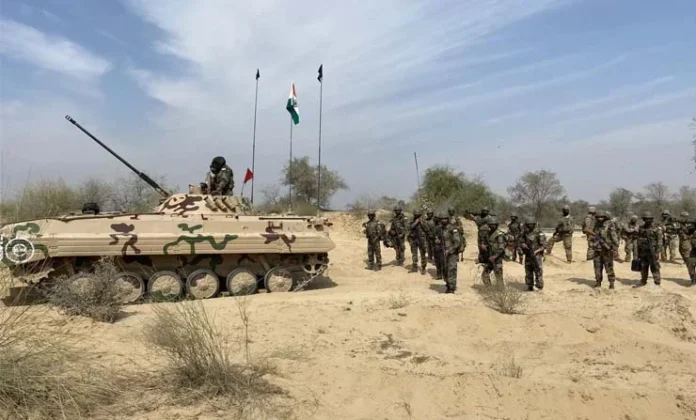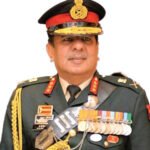General: Mechanised Forces constitute the critical component of a nation’s defence forces in the overall security matrix. They are the instrument of deterrence in peace and force of decision in war. Enriched by their intrinsic characteristics as a mobile protected platform with lethal firepower, they play the dominant role of spearheads in ensuring victory at least cost and minimum time, over the entire operational spectrum. Thus, their capability development and modernisation find increasing focus to prevail in today’s war and win future wars.
Desired Capabilities of Mechanised Forces
Mechanised Forces must be future-ready to operate over the entire operational matrix with multi-spectrum, multi-domain and multi-front capability. Thus, their utility lies in their rapid deployability, multispectral employability and combat overmatch capability to be a decisive force. In the Indian operational context, it translates into the following desired capabilities:
- Deterrence capability based on the medium-class contemporary state-of-the-art MBTs and ICVs essentially for the western front and selectively for the northern front.
- Lighter and versatile light tanks and wheeled ICVs for employment in marginal and high-altitude terrain where medium tanks cannot operate.
- Be the driver for combined arms teams which radiate effects in the battle for decisive victory in an essentially networked battle space. Thus, their employment must be seen in the context of an enlarged mechanised forces canvas including Attack Helicopters, Self-Propelled Arty and Self-Propelled Air Defence besides other mobile combat support and mobile logistics elements.
- 4GW environment and Hybrid War will mandate high survivability and critical capability to identify the threat, close in, contain and neutralise it. Mechanised Forces as part of a combined arms task force must generate this capability.
- Be the forerunner of Indigenous technology induction through a spiral approach and a compeller for tri-service synergy.
- Faced with a hostile nuclear neighbourhood, mechanised forces spearheads must generate the capability to operate under a CBRN environment with intrinsic protection capability.
- Meet commitments of out-of-area contingencies and UN deployment in tune with aspiring national interest.
Modernisation must be driven by the operational requirements and balance the technological, indigenous and fiscal realities in a time-critical domain to achieve the stated objectives. It should build on the principles of retaining the capacity and readiness to accomplish combat superiority and expand new technology-enabled state-of-the-art capabilities to cope with emerging threats
Modernisation Perspective
Modernisation Focus: Modernisation must be driven by the operational requirements and balance the technological, indigenous and fiscal realities in a time-critical domain to achieve the stated objectives. Future force modernisation, thus, needs to build on the principles of retaining the capacity and readiness to accomplish combat superiority, expand new technology-enabled state-of-the-art capabilities to cope with emerging threats and future warfare, harness joint force capabilities and optimise indigenous defence industrial base.
To build and maintain these fundamental capabilities, we must make affordable, sustainable, and integrate rapidly evolving mature technologies to avoid obsolescence while investing in military-unique technologies for the future, and cost-effective decisions which provide versatile and tailorable capabilities. The challenge lies in devising a dynamic and innovative modernisation strategy defining the ends, aligning the ways and prioritising the means, all within the existing fiscal realities.
The pillars would rest on a balanced strategy called SUDRO:
- Sustain current fleet and address voids.
- Upgrade legacy fleet to bridge technological gaps
- Develop new future capabilities for combat overmatch and induct next-generation fleet.
- Replace obsolete and beyond-service life equipment progressively.
- Optimise indigenous capability for a spiral approach to technological challenges and defence production.
Modernisation Fundamentals
Mechanised Forces modernisation plans must be based on the foundational edifice of the following factors:
- Driven by a long-term vision & a womb-to-tomb fleet management perspective which is holistic, realistic and time-sensitive. The right balance of sustenance and modernisation is an important function.
- Prioritised and tiered modernisation based on value & vulnerability analysis with judicious scaling to address our operational imperatives. A spiral approach with a focus on indigenous solutions must be fostered.
- Shift from the erstwhile Iron Triangle of Firepower, Protection and Mobility to a more relevant and holistic model of Lethality, Survivability, Manoeuvrability, Sustainability, Connectivity, Multi-role Adaptability and Affordability based on commonality of base platform and technology convergence.
- Right-sizing and balancing the fleet modernisation/ upgradation, fleet replacement and fleet expansion, based on a realistic fiscal envelope and our operational imperatives, in time and space.
- Judicious mix of mature & contemporary technology, based on pragmatic and realistic qualitative requirements. A good mature technology may be more sensible than the immediate chase for state-of-the-art technology.
- Short evolutionary cycle/time sensitivity is another important factor. “Concept to Product Cycle” must be shorter than the “Technology Change Cycle”.
- Also, for upgrades and legacy fleet modernisation, the product-to-fitment cycle must be compressed with modular form upgrades and field fitments.
Modernisation plans must be driven by a long-term vision & a womb-to-tomb fleet management perspective which is holistic, realistic and time-sensitive. The right balance of sustenance and modernisation is an important function. The art of modernisation will be to balance capability, sustainability, and readiness within the allocated resources to achieve the desired ends
Contours of Modernisation Strategy
The art of modernisation will be to balance capability, sustainability, and readiness within the allocated resources to achieve the desired ends. This requires us to build our equipping priorities based on value, vulnerability and risks in temporal terms. The contours of such a strategy will entail:
- Tiered Modernisation. This approach prioritises in terms of progressive capabilities and tiered modernisation while mitigating the risks of low funding reality. The Army must place priority on formations most operationally critical to be equipped with the best, that is, those facing the greatest risk and providing the maximum payoffs when employed in battle. A large army must refine its scaling philosophy for realistic modernisation needs within defined budgetary support.
- Spiral Approach to Technology Induction. Many capability gaps can be closed with equipment or mature technologies that already exist; this will also shorten acquisition timelines, enabling us to buy more often and divest rather than sustain some legacy items. Simultaneously develop R & D for state of art technologies for future time-critical technology infusion in the midterm. In the long term invest in Science and Technology projects for generation after the next disruptive technologies. This spiral and progressive approach based on indigenous solutions needs to be institutionalised.
- Value – Vulnerability and Risk Analysis. Modernisation strategy must give quantifiable upgraded value and mitigate vulnerabilities of the warfighters. Risk is a function of the values of threat, consequence, and vulnerability in time and space. Prioritised modernisation must be based on acquisitions adding maximum value to combat effectiveness, mitigating critical vulnerabilities and accepting certain risks in temporal terms. Risk must be assessed in temporal terms and accepted in certain areas to ensure that the more critical areas are added value while mitigating vulnerabilities.
- Cost Informed Decisions. Modernisation decisions must be affordable and cost-effective within the overall budget to include life cycle costs. The opportunity cost of “over-spending” to close a specific high-cost gap is that we will not be able to afford to close several other gaps; thus, we must make cost-informed decisions to manage the ‘best bang for the buck’.
Modernisation decisions must be affordable and cost-effective within the overall budget to include life cycle costs. The opportunity cost of ‘over-spending’ to close a specific high-cost gap is that we will not be able to afford to close several other gaps; thus, we must make cost-informed decisions to manage the ‘best bang for the buck’
- Balance Modernisation and Sustenance. Modernisation and sustenance cannot be progressed in compartmentalised mindsets. The fiscal requirements for modernisation must be carefully balanced against the fiscal requirements necessary for sustaining the force at hand in its life cycle. Thus, the standardisation and commonality of a family of platforms and interoperable technologies will reduce sustenance costs with better inventory management.
- Cost Benefit of Sustaining Legacy Equipment. To generate additional resources for modernisation, we must accept risk by divesting older systems to decrease sustainment costs; when planning platform replacements and upgrades, assess the economically sustainable life of the current platforms to determine the cost-benefit of continuing to sustain, upgrade or replace the platform.
- Indigenous Solutions to Indian Warfighting. Indigenous capability is a critical contributory factor of strategic autonomy. Thus, modernisation must be based on indigenous capabilities even if marginally lower, and where insufficient then based on a collaboration with foreign partners, yet ensuring levers in our hands.
Conclusion
Capability building and modernisation of Mechanised Forces require a long-term fleet management perspective and a coherent institutionalised modernisation strategy. These must be periodically reviewed given the dynamics of the operational environment, threat and technology manifestation. A proactive yet inclusive approach is the need of the hour.
-The author is a PVSM, AVSM, VSM has had an illustrious career spanning nearly four decades. A distinguished Armoured Corps officer, he has served in various prestigious staff and command appointments including Commander Independent Armoured Brigade, ADG PP, GOC Armoured Division and GOC Strike 1. The officer retired as DG Mechanised Forces in December 2017 during which he was the architect to initiate process for reintroduction of Light Tank and Chairman on the study on C5ISR for Indian Army. Subsequently he was Consultant MoD/OFB from 2018 to 2020. The Officer is a reputed defence analyst, a motivational speaker and prolific writer on matters of military, defence technology and national security.The views expressed are personal and do not necessarily carry the views of Raksha Anirveda
The author, a PVSM, AVSM, VSM has had an illustrious career spanning nearly four decades. A distinguished Armoured Corps officer, he has served in various prestigious staff and command appointments including Commander Independent Armoured Brigade, ADG PP, GOC Armoured Division and GOC Strike 1. The officer retired as DG Mechanised Forces in December 2017 during which he was the architect to initiate process for reintroduction of Light Tank and Chairman on the study on C5ISR for Indian Army. Subsequently he was Consultant MoD/OFB from 2018 to 2020. He is also a reputed defence analyst, a motivational speaker and prolific writer on matters of military, defence technology and national security. The views expressed are personal and do not necessarily carry the views of Raksha Anirveda






